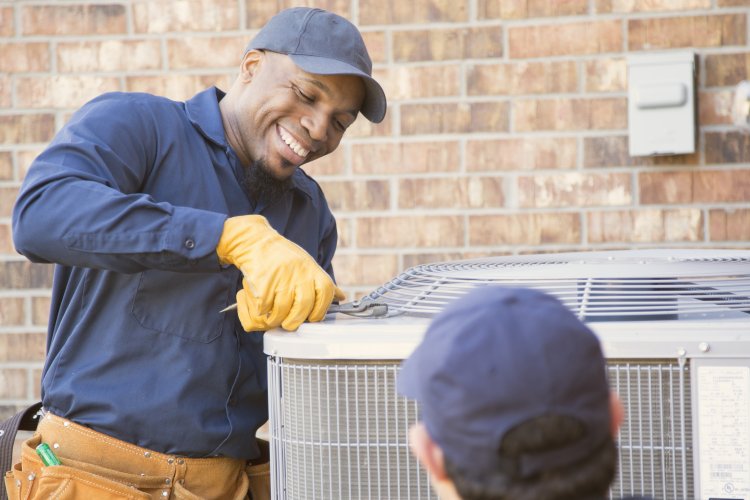
This blog was written by the Midwest Heating & Cooling Collaborative.
A recent New York Times article has created a lot of attention around the efficacy of heat pumps. Their simple 2-question survey on whether or not a heat pump will work for your region raised a common concern: Are heat pumps cost-effective in regions with high electricity prices?
It’s a fair question and one we hear often in the Midwest, where natural gas rates are quite cheap. But the article left out a crucial option that many efficiency programs, contractors, and homeowners are already embracing: dual fuel systems.
By combining an electric heat pump with a gas furnace, dual fuel (or hybrid) systems offer flexible, efficient heating year-round, and they can still deliver savings even when electric rates are steep.
Here are some key points missing from the article and why dual fuel systems deserve a closer look.
Smarter Switching, Lower Bills
Dual fuel systems automatically switch between the electric heat pump and the gas furnace depending on outside temperature. When it’s mild out, the heat pump runs at 200-400% efficiency (a coefficient of performance of 2-4+). Because heat pumps transfer heat rather than generate it, their efficiency naturally declines as outdoor temperatures drop. That doesn’t mean they stop providing heat; it simply means they’re operating at a lower efficiency than under ideal conditions.
When the temperature drops too low for the heat pump to maintain an indoor set point, the gas furnace takes over. This avoids the high cost of electric resistance heating, a key cost factor the NYT didn’t fully account for. Electric resistance heating is a backup or supplemental heat source built into many heat pump systems and is programmed to kick on if the heat pump can no longer maintain the indoor temperature set point. Electric resistance heating is widely known to be one of the least efficient methods of space heating. Hybrid systems will use the gas furnace as backup instead, eliminating the energy-intensive electric resistance.
The switchover temperature can be optimized for comfort, cost or carbon, whichever the homeowner cares most about. If your switchover temperature is too high, you may be losing out on efficient heating hours that cost less than your gas furnace. Pairing a dual fuel heat pump with weatherization to improve the building envelope and decrease the heating load improves the economics even more.
Retrofitting is Often Easier Than Replacing
Here’s something the NYT article missed: most homes already have a gas furnace. That means going to dual fuel often only involves adding a heat pump, not replacing the entire system. This makes dual fuel especially appealing for retrofit programs.
In many cases:
- Existing ductwork can be utilized
- Typically, no electric panel upgrade is needed
- Contractors can install systems with minimal disruption
- Some states and utilities have incentives and tax credits (although some of these are sunsetting) to help minimize the upfront cost to install a heat pump
Grid Resilience
In winter, electric resistance heating or heat pumps alone can strain the grid during extreme cold snaps. Dual fuel systems can switch to gas heating during those peak times, reducing electric demand when the grid is most stressed. If paired with smart controls or utility programs, dual fuel systems can respond to real-time grid signals and shift usage away from high-demand periods. The connected systems can also help balance intermittent renewables like wind and solar.
Why This Matters for Programs and Partners
The NYT article raised important questions, but it overlooks solutions that energy efficiency advocates, program designers, and contractors are already deploying. The Midwest Collaborative did research to understand the applicability of dual fuel heat pumps in the Midwest and found that hybrid heat pumps are particularly well-suited for the region’s climate. In many cases, dual fuel systems offer flexibility, resilience, and cost savings while expanding consumer choices. The project team also ran models using location-specific inputs to further understand how dual fuel heat pumps perform in the Midwest and to display potential opportunities and impacts. Read the full report on the Midwest Collaborative website.
While the NYT article will help raise awareness among consumers about heat pumps, it can also set a dangerous precedent that heat pumps aren’t economically viable in the Midwest. A heat pump won’t be the right choice for every home, but there are a myriad of opportunities to use a heat pump to efficiently and affordably heat and cool homes throughout the region. As heat pumps are still relatively nascent here in the Midwest, the Midwest Heating and Cooling Collaborative is working to ensure program administrators and contractors have the resources and technical assistance needed to make high-performance HVAC technology, like dual fuel heat pumps, the first choice for all homeowners.
Learn more at mwcollab.org.